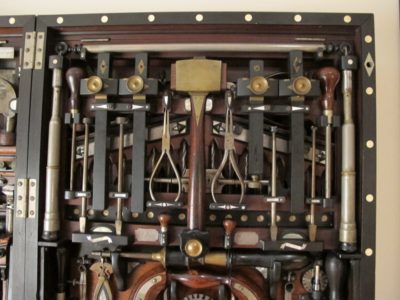Studley Mallet Casting, A Curiosity
 Examining the original mallet in HO Studley’s tool ensemble and comparing it to the foundry practices I was taught 40+ years ago, several things came clearly(?) into focus. First and foremost, this might be the most exquisite sand casting I’ve ever seen. Certainly it was way better than anything our foundry produced, and I think we had a top-of-the-heap casting quality. On the iron/steel side of things the foundry could produce excellent castings up to a 10,000 pound heat size, and on the brass/bronze side the limit was about 600 pounds. The molders were first rate and experienced, the Pour Masters had been doing it since the Mezozoic Age, but even then our castings were nothing like that evident on Studley’s mallet.
Examining the original mallet in HO Studley’s tool ensemble and comparing it to the foundry practices I was taught 40+ years ago, several things came clearly(?) into focus. First and foremost, this might be the most exquisite sand casting I’ve ever seen. Certainly it was way better than anything our foundry produced, and I think we had a top-of-the-heap casting quality. On the iron/steel side of things the foundry could produce excellent castings up to a 10,000 pound heat size, and on the brass/bronze side the limit was about 600 pounds. The molders were first rate and experienced, the Pour Masters had been doing it since the Mezozoic Age, but even then our castings were nothing like that evident on Studley’s mallet.
Admittedly we were making industrial machinery where surface finish was generally of little importance, so we might have used a coarser sand than was used for the mallet head. I believe it came directly from the sand with minimal clean-up and it is glorious. (Alternately the surface was worked — cutting off sprues and gates, etc. — and then bead blasted, but the level of crisp detail remaining might argue against that. Since I was not allowed to disassemble the mallet head [this could not have been accomplished without completely destroying the object, a sorta Studleyesque version of the Heisenberg Uncertainty Principle] much of my thinking at this point is pure conjecture because I cannot make direct observations).

Of my hundreds of images of the mallet, the one shows the casting “seam” most clearly (my foundry’s term for this was “the flashing line”). My main question to myself is, “Do I want to make this exactly as did the original patternmaker and foundryman, or do I make the way most in keeping with my own experience?”
As a patternmaker, and I am currently working up the patterns for casting the infill mallet head myself, I was struck by the orientation of Studley’s mallet casting. My history and inclinations would lead me to make the casting as though the mallet was laying down flat, in other words splitting the pattern and the casting along a vertical plane dividing the casting roughly in half. The Studley mallet casting was turned 90 degrees from the way I would do it, and required the core (the block of sand that occupies the empty internal space) to be inserted into the floor and ceiling of the sand mold rather than laid in the dividing line of the mold.
As I move forward I will blog about all of this in great detail, probably more than you ever wanted to know.
Stay tuned.



Hi I have been looking at the Studley mallet online. My curiosity was aroused by the advertising of three from Jim Bode tools. Each at different weights.
My question is what size are those mallet heads?
I have a Lee Valley bronze cast mallet which is to me surprisingly small .
Hence my question as I have no way of establishing the relative sizes of the heads offered up in the picture from Jim Bode tools.
maybe it was printed :-)